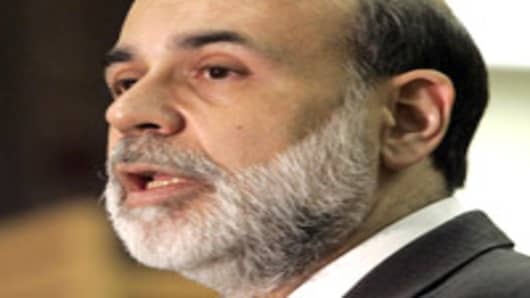Central banks around the globe banded together to make it easier for stressed banks to borrow money in the midst of a credit crunch that threatens to knock the U.S. economy into recession and slow growth worldwide.
The steps, announced jointly by the Federal Reserve, the European Central Bank and the central banks of Canada, England and Switzerland, were aimed at tamping down a financial
crisis that erupted this summer when record housing foreclosures left banks leary of lending.
The Bank of Japan and Sweden's Riksbank also issued statements that they are lending
support to the plan.
"This is the biggest act of global economic cooperation since September 11," said Sherry Cooper, chief economist for BMO Capital Markets in Toronto, referring to a global credit
easing launched after the World Trade Center attacks.
The news initially brought a wave of relief to financial markets after sharp declines the previous day when the Fed's modest cut in interest rates dashed hopes of a more aggressive strike.
But by early Wednesday afternoon, stocks had reversed course after gloomy forecasts from three big banks and investors weighed the implications of the proposed plan. The Dow industrials ended up only 41 pointsafter jumping 250 points initially. Bond prices edged lower.
'Temporary Term Auction'
The Fed said, in announcing the proposal, said it would launch a "temporary term auction facility" that banks can use to secure loans at its discount window. The move expands the
number and reach of banks allowed to borrow money to meet temporary shortages of funds.
The U.S. central bank announced two auctions of up to $20 billion each in short-term funding next week, with others raising unspecified amounts to follow in January.
"This facility could help promote the efficient dissemination of liquidity when the unsecured interbank markets are under stress," the Fed said in a statement.
A Fed official who briefed reporters said the auction system might erase some of the stigma associated with borrowing at the discount window by providing a cloak of anonymity. The
move also addresses raising dollars for foreign investors with stressed U.S. assets.
The U.S. central bank did so by opening foreign exchange swaps for up to $20 billion with the European Central Bank and up to $4 billion with the Swiss National Bank.
The ECB said it would use the swap facility to offer European institutions dollar funding in any cases where Europeans financial firms encounter "elevated pressures" in short-term credit markets.
"In effect, the Fed will lend dollars to these central banks, which can then lend them to commercial banks in Europe," Wachovia Corp economist Jay Bryson said in a research note.
Rising defaults on U.S. subprime mortgages set in train a global tightening of credit this summer as banks, worried over possible repayment failures, stopped lending to each other.
Like the Fed, the Bank of Canada said it would launch a temporary auction auction facility. It also said it would expand the list of securities eligible as collateral for central bank loans. The Bank of England said it would offer three-month loans against a wider range of collateral.
Failing to Soothe Worries
The moves come after interest rate cuts by the Fed, the Bank of Canada and the Bank of England failed to soothe worries that banks would continue to pull back from lending.
The Fed on Tuesday cut the benchmark federal funds rate a modest quarter-percentage point to 4.25 percent and trimmed the discount rate charged on direct Fed loans banks for loans by
the same amount.
Fed and ECB officials said the steps announced Wednesday had been under consideration for some time and were not aimed at helping any particular institution, but instead were meant
to help markets generally function more smoothly.
"This is not about particular financial institutions with particular problems. It is about market functioning," a senior Fed official said, adding that the announcements were not in
response to market disappointment with Fed's rate cut decision on Tuesday.
Markets and policy-makers have been caught off guard by how hard and broadly rising defaults on U.S. subprime mortgages have hit. As roughly 1.8 million adjustable rate mortgages line
up for reset at sharply higher interest rates in 2008, homeowners and banks may face more pain ahead.



